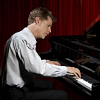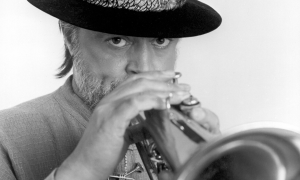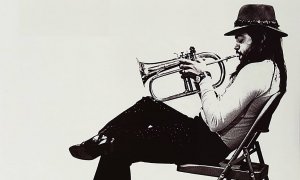Home » Jazz Articles » Catching Up With » The Andy Ostwald Trio: A Field Guide
The Andy Ostwald Trio: A Field Guide

Courtesy Jarrod Gustin
Ostwald is a San Francisco Bay Area-based musician who performs as a soloist, band leader, and sideman, and as a member of Jeff Sanford's Cartoon Jazz Nonet. He teaches piano at his home in Oakland, and is an instructor at Oaktown Jazz Workshops, a community-based afterschool program for young people ages 10-18.
Here, Ostwald talks about his new album and his life in music.
All About Jazz: What was the genesis of Field Guide?
Andy Ostwald: I know trumpeter Eric Wayne, owner of the Digital Victrola label, from performing with him in Jeff Sanford's Cartoon Jazz Nonet. Eric asked if I'd like to record a trio album featuring piano, bass, and drums, and added that I would have complete artistic freedom. He made it easy for me to say yes.
As for the trio itself, Ravi Abcarian [bass], Bryan Bowman [drums], and I started playing together on occasion a couple of decades ago, but the band really came together when Ravi landed a gig in the North Beach district of San Francisco in 2011; that's when we really got to know one another musically, and when we developed a group sound. We were lucky— the engagement lasted for five years.
AAJ: How did you go about choosing songs for the album?
AO: First and foremost: I love these tunes. I also love that each one offers an interesting set of chords over which to improvise. Of course with such a diversity of styles, I had to be careful to choose tunes that would work well together on the album.
I was also interested in including tunes that were written for an instrumentation other than our piano-bass-drum trio. For example, Nat Adderley wrote "Sweet Emma" for a quintet featuring cornet and alto saxophone; Keith Jarrett created "Memories of Tomorrow" for solo piano. Adapting the tunes for the trio meant creating our own interpretations, which is a process that I'm drawn to.
AAJ: How did you approach your adaptations?
AO: Each tune called for something different, but "Sweet Emma" will serve as a good illustration: In Nat Adderley's original arrangement, the melody and its harmony part are played by a cornet and alto saxophone. In our arrangement, my right hand plays the melody and its harmony part while my left hand creates an accompaniment. Ravi and Bryan adjusted their approach to complement this adaptation.
AAJ: Did you make other fundamental changes to any of the songs?
AO: I changed the underlying rhythmic feel of two tunes. First, I replaced the swing groove of the Sam Rivers tune, "Beatrice," with a Latin groove. Second, I changed the meter of the Jimmy Van Heusen tune, "Like Someone in Love" from common time (4/4) to a jazz waltz (3/4).
AAJ: Tell me a bit about your musical background?
AO: My dad played a valuable role in my early musical development. Sometimes, while practicing my scales on the piano, he would pick up his violin and improvise melodies over those scales, which both delighted and fascinated me. Dad also made it a point to introduce me to his favorite early jazz and classical recordings.
When I was fourteen, I attended a clinic by jazz pianist Dan Hearle where I was introduced to the music of Herbie Hancock, Ahmad Jamal, and Oscar Peterson. The music of these three jazz piano titans moved and mystified me, and steered me towards jazz.
During my college years, I focused on performing contemporary jazz, the classical European repertoire, and the gamelan music of Java. A few years later I studied in New York with the exceptional jazz pianist, Harold Mabern.
AAJ: Tell me a little about the members of your band and your musical careers up to this point.
AO: I'm fortunate to be playing with two remarkable musicians. Our bassist, Ravi Abcarian, has performed with saxophonists Chico Freeman, Joshua Redman and Sonny Simmons, and with Sweet Honey in the Rock. Ravi is both the executive director and an instructor at Oaktown Jazz Workshops.
Like Minds, the debut album of our drummer, Bryan Bowman, was named on two nationwide "Best of 2015" lists. Bryan is also the author of the drum method book Syncopation Companion which received high praise from drummer Peter Erskine, and from the Berklee College of Music in Boston.
As for myself, I've performed in the San Francisco Bay Area since 1985. I've also toured a good deal in the states and abroad with vocalist Diane Witherspoon. My book/audio series, Play Jazz, Blues, Rock Piano by Ear, was published in 2004 and remains in print today.
AAJ: Getting back to the album, tell me about the one original composition you included—"Meadow's Edge."
AO: The origin of that tune goes way back. I was in a house band in the 1980s in San Francisco that played five nights a week. We often got a request to play Paul Desmond's "Take Five," made famous by the Dave Brubeck Quartet. Instead of soloing over the chords in the song, I wrote my own chords. These chords, in turn, became the harmonic foundation for "Meadow's Edge."
AAJ: I can't help noticing that both the album title and your composition's title are nods towards nature.
AO: Spending time in the natural world is a source of inspiration for me. Stillness and quietude are, for me, complimentary to making music. Although field guides typically help us identify the plants, animals, and/or natural formations of a given environment, I wanted to apply this term to something a little less down-to-earth. The suggestion with this album title is that music—and the arts in general—can help us understand an internal landscape. They can help bring clarity and a new perspective to what's going on in our mind and in our heart.
AAJ: One last question: Do you have plans for a next album?
AO: I haven't made any specific plans, but I do think about tunes that I might want to record in the future. Stay tuned.
Tags
PREVIOUS / NEXT
Support All About Jazz
 All About Jazz has been a pillar of jazz since 1995, championing it as an art form and, more importantly, supporting the musicians who make it. Our enduring commitment has made "AAJ" one of the most culturally important websites of its kind, read by hundreds of thousands of fans, musicians and industry figures every month.
All About Jazz has been a pillar of jazz since 1995, championing it as an art form and, more importantly, supporting the musicians who make it. Our enduring commitment has made "AAJ" one of the most culturally important websites of its kind, read by hundreds of thousands of fans, musicians and industry figures every month.




















